
A research project from Rice University in Houston indicates that without Jupiter, the young Earth could have ventured too closely to the sun, rendering it unfit for habitation. This study examines why the first solid entities in the solar system did not develop concurrently. Data from meteorites reveal two separate waves of materials used for planet construction. The initial group emerged rapidly, while the subsequent group, located nearer to Earth, Mars, and Venus, formed 2 to 3 million years later. Scientists conducted computer simulations to investigate this, identifying Jupiter as a pivotal element. According to Baibhav Srivastava, a planetary scientist and author of the study, Jupiter’s mass, which exceeds the combined mass of all other planets, was instrumental in keeping Earth and its neighboring planets from drifting inward and hindering their development by restricting material supply from the outer solar system.
“Our Earth could have turned into a ‘super-Earth,'” Srivastava informed Mashable. “This could have profound implications for Earth’s potential to sustain life, as it might have exited the solar system’s ‘Goldilocks’ zone.”
The Goldilocks zone refers to the area around a star where conditions permit liquid water to exist on a planet’s surface. Jupiter, often referred to as the architect of the solar system, affected the orbits of other planets and molded the gas and dust from which they originated. As Jupiter expanded, it reshaped the vicinity of the sun, extracting gas from the inner zone and forming high-pressure ridges that ensnared dust, giving rise to new solid entities long after the first ones. This phenomenon accounts for the age discrepancy in rocky space materials, aligning with the timing of ordinary chondrites, which are the most prevalent stony meteorites found on Earth.
Researchers estimate the ages of meteorites by analyzing isotopes, which transform into different elements at predictable rates. By evaluating the remaining original isotope against the decayed quantity, scientists can ascertain when the rock solidified. This technique is analogous to carbon dating but involves heavier elements such as lead, rubidium, and strontium, as explained by Srivastava.
By the time the second wave of rocky materials solidified, Earth was already in the process of formation, suggesting they likely had minimal impact on the planet.
The model indicates that Jupiter’s formation transpired within the initial 2 million years of the solar system’s existence, enabling it to influence the surrounding gas and dust. These discoveries correspond with observations from other developing star systems, stated André Izidoro, a Rice assistant professor and co-author of the study.
“When we observe those youthful disks, we witness the onset of giant planets forming and altering their nascent environment,” Izidoro remarked in a statement. “Our own solar system was no exception. Jupiter’s early development left a trace that we can still decipher today, preserved within meteorites that descend to Earth.”